Analyzing Australian Health Care Reforms: A Comprehensive Overview
VerifiedAdded on 2020/05/01
|19
|4324
|85
AI Summary
The document provides an analytical overview of Australian healthcare reform, emphasizing the evolution of funding models and policies impacting public hospital systems. Key themes include the shift towards activity-based funding, collaborative practices in general practice influenced by new financial frameworks, and innovations in governance within Indigenous health organizations. The study reflects on both successes and challenges faced over decades of policy changes, offering insights into strategies for improved healthcare delivery. It underscores the importance of systemic approaches to health reform, advocating for sustainable models that address diverse community needs while ensuring equitable access to quality care.
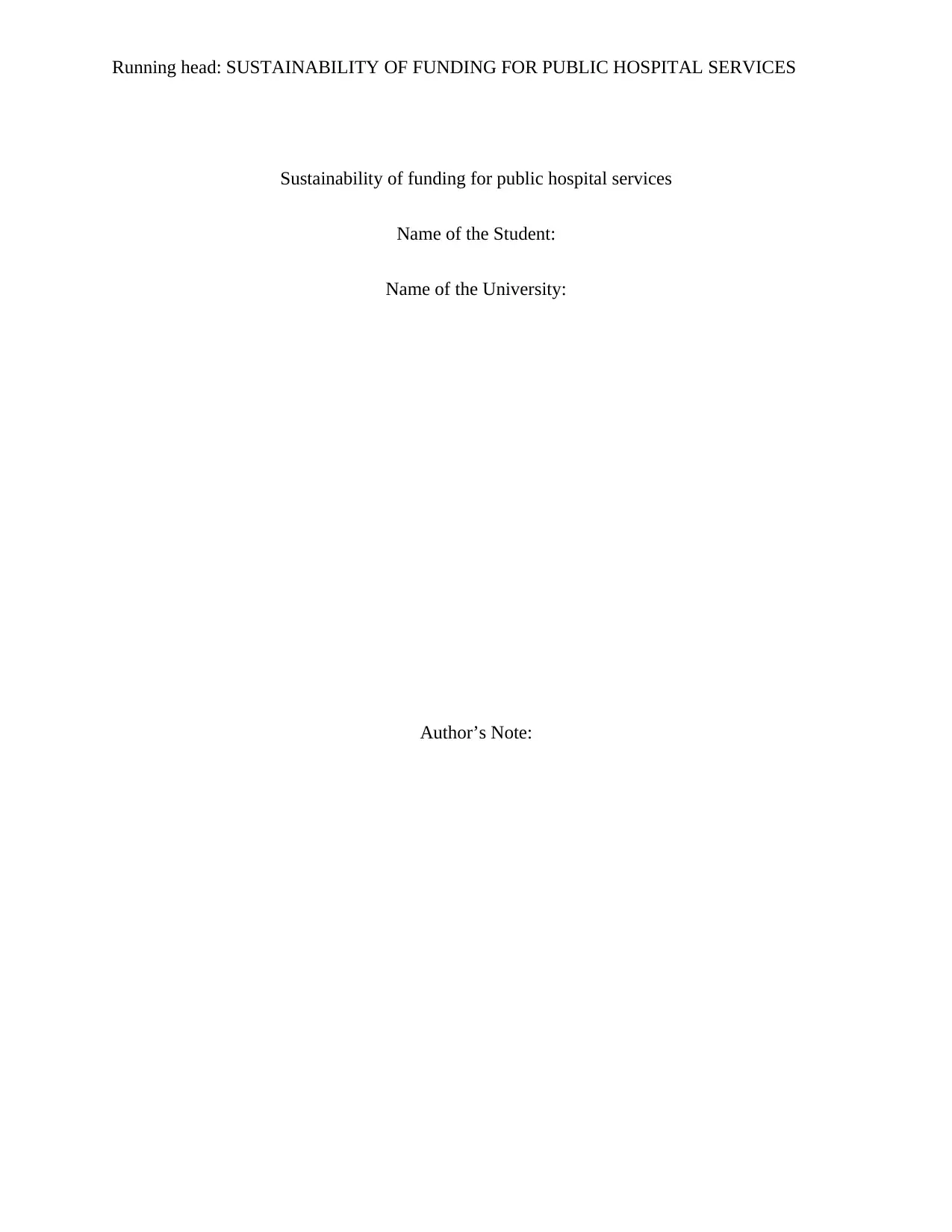
Running head: SUSTAINABILITY OF FUNDING FOR PUBLIC HOSPITAL SERVICES
Sustainability of funding for public hospital services
Name of the Student:
Name of the University:
Author’s Note:
Sustainability of funding for public hospital services
Name of the Student:
Name of the University:
Author’s Note:
Paraphrase This Document
Need a fresh take? Get an instant paraphrase of this document with our AI Paraphraser
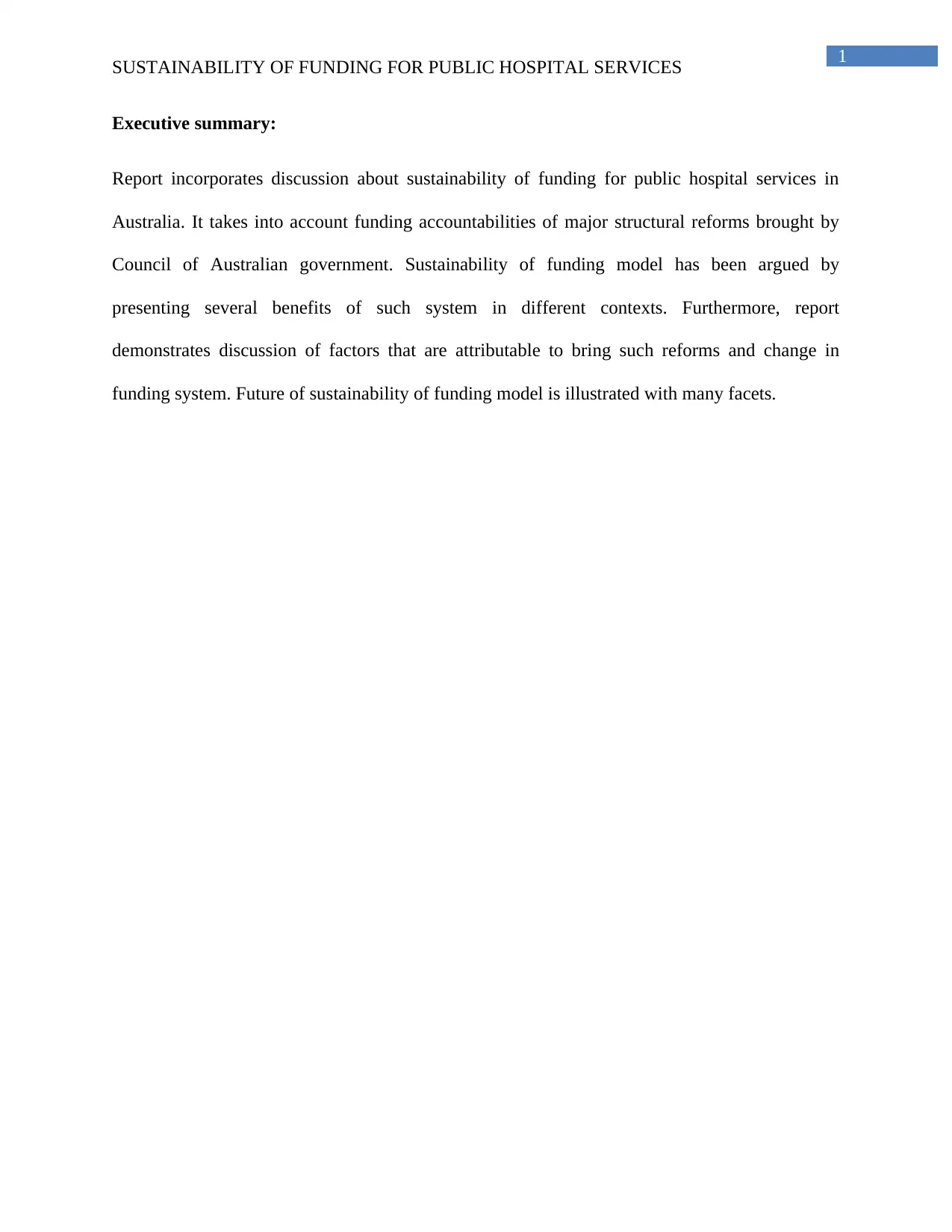
1
SUSTAINABILITY OF FUNDING FOR PUBLIC HOSPITAL SERVICES
Executive summary:
Report incorporates discussion about sustainability of funding for public hospital services in
Australia. It takes into account funding accountabilities of major structural reforms brought by
Council of Australian government. Sustainability of funding model has been argued by
presenting several benefits of such system in different contexts. Furthermore, report
demonstrates discussion of factors that are attributable to bring such reforms and change in
funding system. Future of sustainability of funding model is illustrated with many facets.
SUSTAINABILITY OF FUNDING FOR PUBLIC HOSPITAL SERVICES
Executive summary:
Report incorporates discussion about sustainability of funding for public hospital services in
Australia. It takes into account funding accountabilities of major structural reforms brought by
Council of Australian government. Sustainability of funding model has been argued by
presenting several benefits of such system in different contexts. Furthermore, report
demonstrates discussion of factors that are attributable to bring such reforms and change in
funding system. Future of sustainability of funding model is illustrated with many facets.
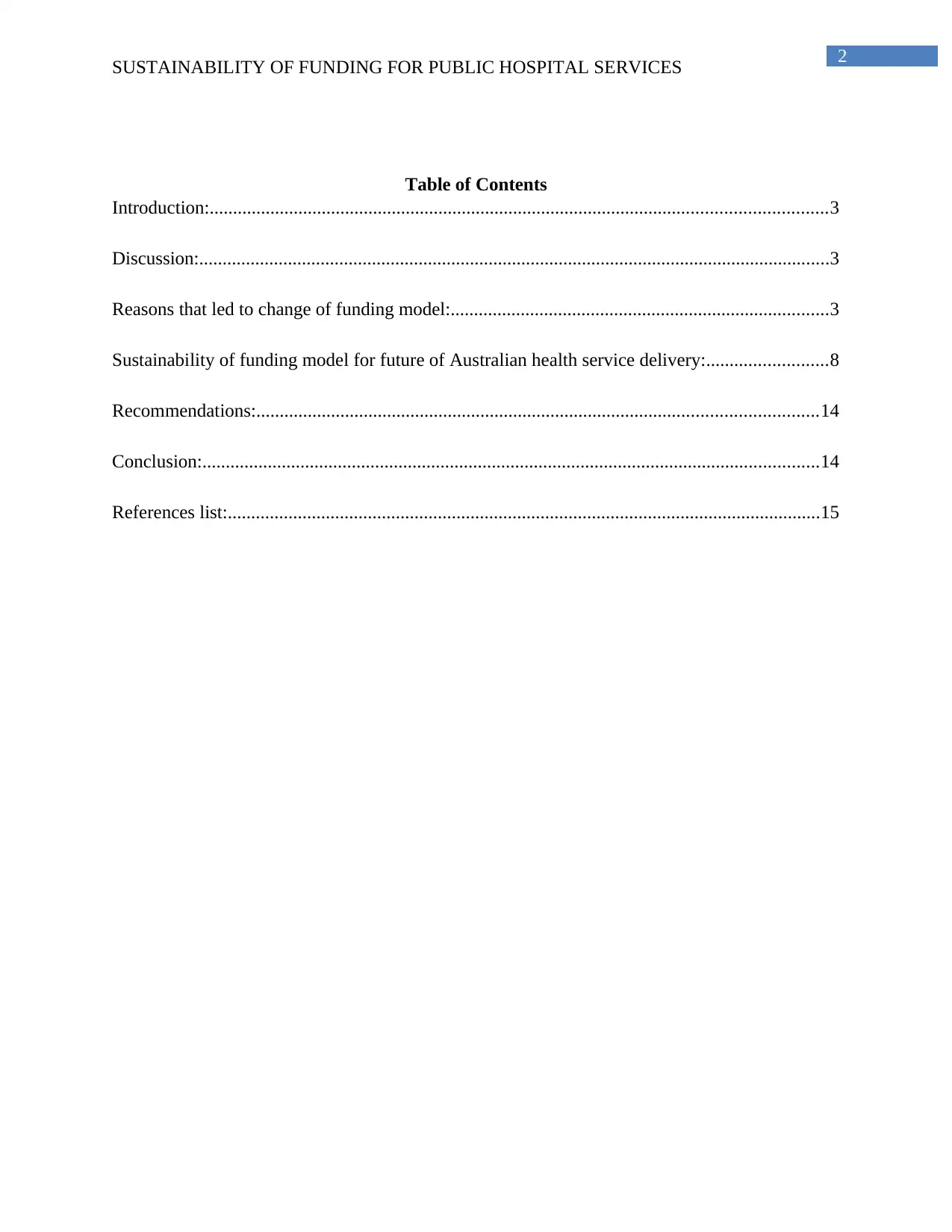
2
SUSTAINABILITY OF FUNDING FOR PUBLIC HOSPITAL SERVICES
Table of Contents
Introduction:....................................................................................................................................3
Discussion:.......................................................................................................................................3
Reasons that led to change of funding model:.................................................................................3
Sustainability of funding model for future of Australian health service delivery:..........................8
Recommendations:........................................................................................................................14
Conclusion:....................................................................................................................................14
References list:...............................................................................................................................15
SUSTAINABILITY OF FUNDING FOR PUBLIC HOSPITAL SERVICES
Table of Contents
Introduction:....................................................................................................................................3
Discussion:.......................................................................................................................................3
Reasons that led to change of funding model:.................................................................................3
Sustainability of funding model for future of Australian health service delivery:..........................8
Recommendations:........................................................................................................................14
Conclusion:....................................................................................................................................14
References list:...............................................................................................................................15
⊘ This is a preview!⊘
Do you want full access?
Subscribe today to unlock all pages.

Trusted by 1+ million students worldwide
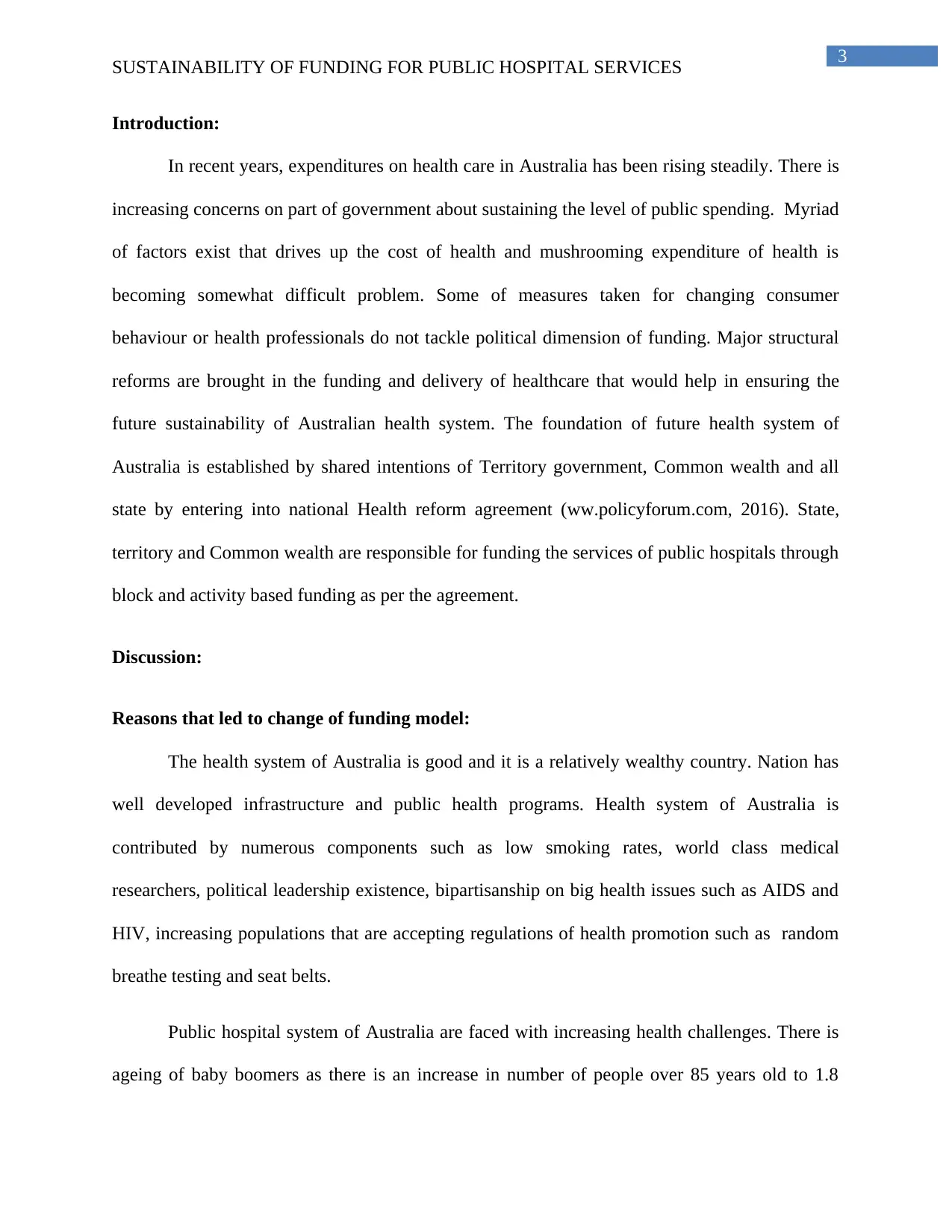
3
SUSTAINABILITY OF FUNDING FOR PUBLIC HOSPITAL SERVICES
Introduction:
In recent years, expenditures on health care in Australia has been rising steadily. There is
increasing concerns on part of government about sustaining the level of public spending. Myriad
of factors exist that drives up the cost of health and mushrooming expenditure of health is
becoming somewhat difficult problem. Some of measures taken for changing consumer
behaviour or health professionals do not tackle political dimension of funding. Major structural
reforms are brought in the funding and delivery of healthcare that would help in ensuring the
future sustainability of Australian health system. The foundation of future health system of
Australia is established by shared intentions of Territory government, Common wealth and all
state by entering into national Health reform agreement (ww.policyforum.com, 2016). State,
territory and Common wealth are responsible for funding the services of public hospitals through
block and activity based funding as per the agreement.
Discussion:
Reasons that led to change of funding model:
The health system of Australia is good and it is a relatively wealthy country. Nation has
well developed infrastructure and public health programs. Health system of Australia is
contributed by numerous components such as low smoking rates, world class medical
researchers, political leadership existence, bipartisanship on big health issues such as AIDS and
HIV, increasing populations that are accepting regulations of health promotion such as random
breathe testing and seat belts.
Public hospital system of Australia are faced with increasing health challenges. There is
ageing of baby boomers as there is an increase in number of people over 85 years old to 1.8
SUSTAINABILITY OF FUNDING FOR PUBLIC HOSPITAL SERVICES
Introduction:
In recent years, expenditures on health care in Australia has been rising steadily. There is
increasing concerns on part of government about sustaining the level of public spending. Myriad
of factors exist that drives up the cost of health and mushrooming expenditure of health is
becoming somewhat difficult problem. Some of measures taken for changing consumer
behaviour or health professionals do not tackle political dimension of funding. Major structural
reforms are brought in the funding and delivery of healthcare that would help in ensuring the
future sustainability of Australian health system. The foundation of future health system of
Australia is established by shared intentions of Territory government, Common wealth and all
state by entering into national Health reform agreement (ww.policyforum.com, 2016). State,
territory and Common wealth are responsible for funding the services of public hospitals through
block and activity based funding as per the agreement.
Discussion:
Reasons that led to change of funding model:
The health system of Australia is good and it is a relatively wealthy country. Nation has
well developed infrastructure and public health programs. Health system of Australia is
contributed by numerous components such as low smoking rates, world class medical
researchers, political leadership existence, bipartisanship on big health issues such as AIDS and
HIV, increasing populations that are accepting regulations of health promotion such as random
breathe testing and seat belts.
Public hospital system of Australia are faced with increasing health challenges. There is
ageing of baby boomers as there is an increase in number of people over 85 years old to 1.8
Paraphrase This Document
Need a fresh take? Get an instant paraphrase of this document with our AI Paraphraser
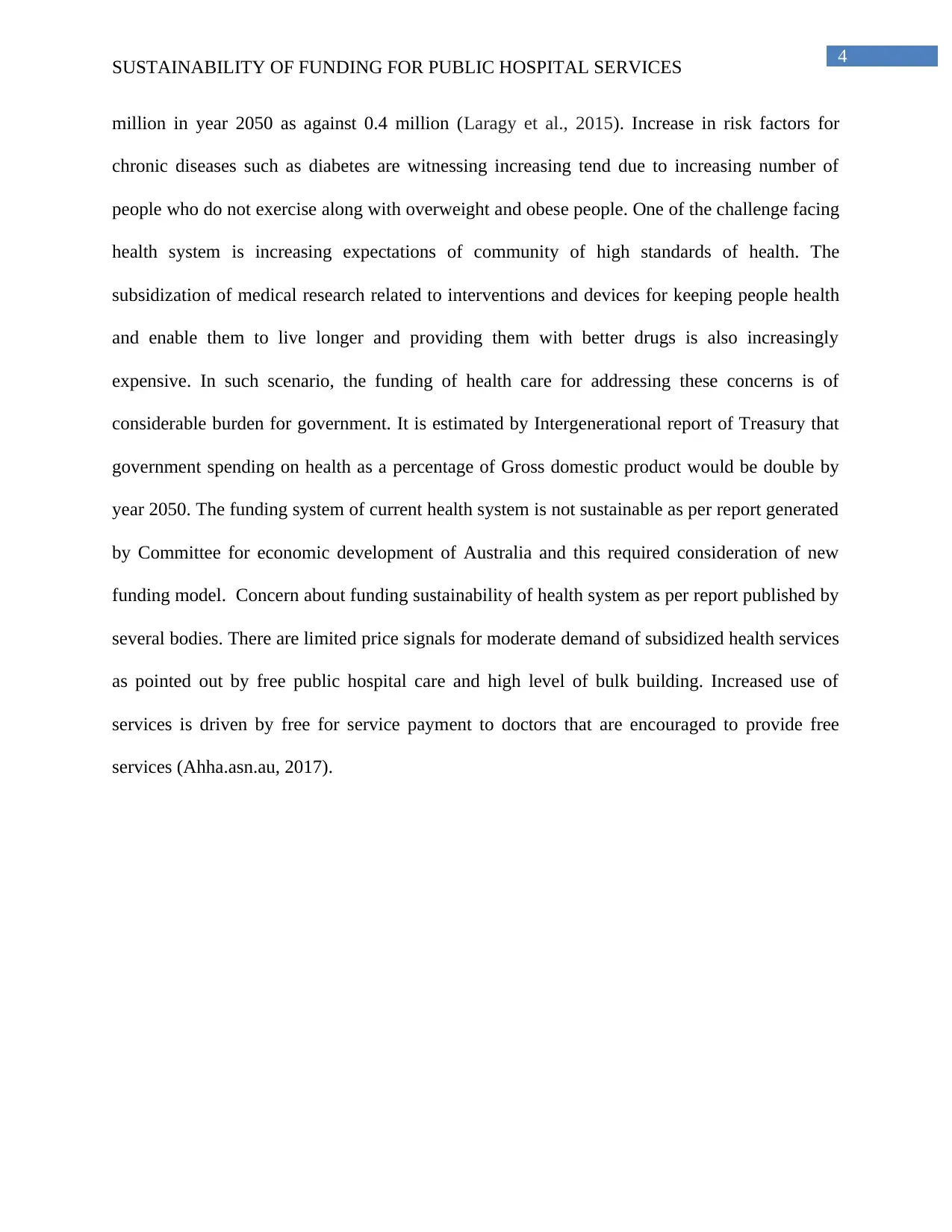
4
SUSTAINABILITY OF FUNDING FOR PUBLIC HOSPITAL SERVICES
million in year 2050 as against 0.4 million (Laragy et al., 2015). Increase in risk factors for
chronic diseases such as diabetes are witnessing increasing tend due to increasing number of
people who do not exercise along with overweight and obese people. One of the challenge facing
health system is increasing expectations of community of high standards of health. The
subsidization of medical research related to interventions and devices for keeping people health
and enable them to live longer and providing them with better drugs is also increasingly
expensive. In such scenario, the funding of health care for addressing these concerns is of
considerable burden for government. It is estimated by Intergenerational report of Treasury that
government spending on health as a percentage of Gross domestic product would be double by
year 2050. The funding system of current health system is not sustainable as per report generated
by Committee for economic development of Australia and this required consideration of new
funding model. Concern about funding sustainability of health system as per report published by
several bodies. There are limited price signals for moderate demand of subsidized health services
as pointed out by free public hospital care and high level of bulk building. Increased use of
services is driven by free for service payment to doctors that are encouraged to provide free
services (Ahha.asn.au, 2017).
SUSTAINABILITY OF FUNDING FOR PUBLIC HOSPITAL SERVICES
million in year 2050 as against 0.4 million (Laragy et al., 2015). Increase in risk factors for
chronic diseases such as diabetes are witnessing increasing tend due to increasing number of
people who do not exercise along with overweight and obese people. One of the challenge facing
health system is increasing expectations of community of high standards of health. The
subsidization of medical research related to interventions and devices for keeping people health
and enable them to live longer and providing them with better drugs is also increasingly
expensive. In such scenario, the funding of health care for addressing these concerns is of
considerable burden for government. It is estimated by Intergenerational report of Treasury that
government spending on health as a percentage of Gross domestic product would be double by
year 2050. The funding system of current health system is not sustainable as per report generated
by Committee for economic development of Australia and this required consideration of new
funding model. Concern about funding sustainability of health system as per report published by
several bodies. There are limited price signals for moderate demand of subsidized health services
as pointed out by free public hospital care and high level of bulk building. Increased use of
services is driven by free for service payment to doctors that are encouraged to provide free
services (Ahha.asn.au, 2017).
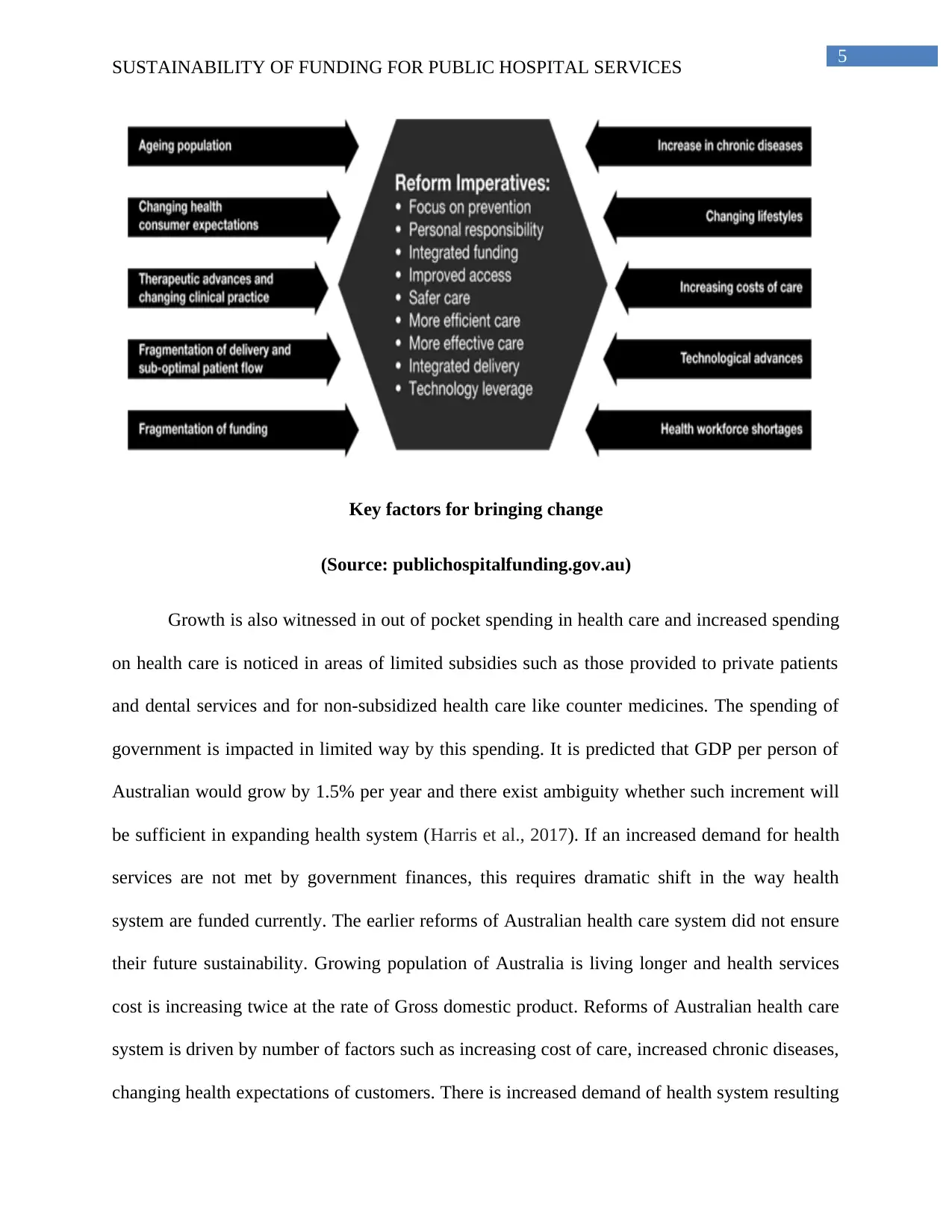
5
SUSTAINABILITY OF FUNDING FOR PUBLIC HOSPITAL SERVICES
Key factors for bringing change
(Source: publichospitalfunding.gov.au)
Growth is also witnessed in out of pocket spending in health care and increased spending
on health care is noticed in areas of limited subsidies such as those provided to private patients
and dental services and for non-subsidized health care like counter medicines. The spending of
government is impacted in limited way by this spending. It is predicted that GDP per person of
Australian would grow by 1.5% per year and there exist ambiguity whether such increment will
be sufficient in expanding health system (Harris et al., 2017). If an increased demand for health
services are not met by government finances, this requires dramatic shift in the way health
system are funded currently. The earlier reforms of Australian health care system did not ensure
their future sustainability. Growing population of Australia is living longer and health services
cost is increasing twice at the rate of Gross domestic product. Reforms of Australian health care
system is driven by number of factors such as increasing cost of care, increased chronic diseases,
changing health expectations of customers. There is increased demand of health system resulting
SUSTAINABILITY OF FUNDING FOR PUBLIC HOSPITAL SERVICES
Key factors for bringing change
(Source: publichospitalfunding.gov.au)
Growth is also witnessed in out of pocket spending in health care and increased spending
on health care is noticed in areas of limited subsidies such as those provided to private patients
and dental services and for non-subsidized health care like counter medicines. The spending of
government is impacted in limited way by this spending. It is predicted that GDP per person of
Australian would grow by 1.5% per year and there exist ambiguity whether such increment will
be sufficient in expanding health system (Harris et al., 2017). If an increased demand for health
services are not met by government finances, this requires dramatic shift in the way health
system are funded currently. The earlier reforms of Australian health care system did not ensure
their future sustainability. Growing population of Australia is living longer and health services
cost is increasing twice at the rate of Gross domestic product. Reforms of Australian health care
system is driven by number of factors such as increasing cost of care, increased chronic diseases,
changing health expectations of customers. There is increased demand of health system resulting
⊘ This is a preview!⊘
Do you want full access?
Subscribe today to unlock all pages.

Trusted by 1+ million students worldwide
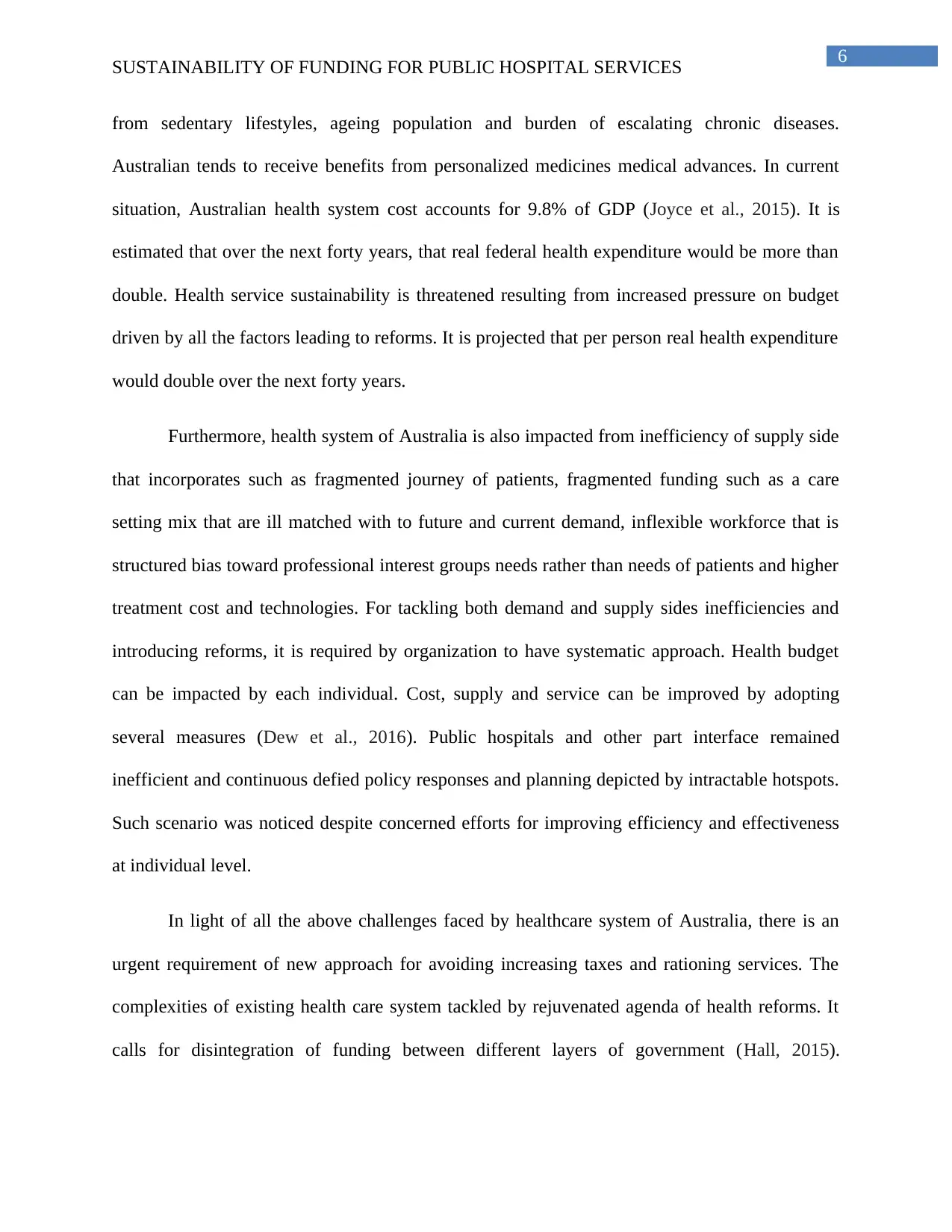
6
SUSTAINABILITY OF FUNDING FOR PUBLIC HOSPITAL SERVICES
from sedentary lifestyles, ageing population and burden of escalating chronic diseases.
Australian tends to receive benefits from personalized medicines medical advances. In current
situation, Australian health system cost accounts for 9.8% of GDP (Joyce et al., 2015). It is
estimated that over the next forty years, that real federal health expenditure would be more than
double. Health service sustainability is threatened resulting from increased pressure on budget
driven by all the factors leading to reforms. It is projected that per person real health expenditure
would double over the next forty years.
Furthermore, health system of Australia is also impacted from inefficiency of supply side
that incorporates such as fragmented journey of patients, fragmented funding such as a care
setting mix that are ill matched with to future and current demand, inflexible workforce that is
structured bias toward professional interest groups needs rather than needs of patients and higher
treatment cost and technologies. For tackling both demand and supply sides inefficiencies and
introducing reforms, it is required by organization to have systematic approach. Health budget
can be impacted by each individual. Cost, supply and service can be improved by adopting
several measures (Dew et al., 2016). Public hospitals and other part interface remained
inefficient and continuous defied policy responses and planning depicted by intractable hotspots.
Such scenario was noticed despite concerned efforts for improving efficiency and effectiveness
at individual level.
In light of all the above challenges faced by healthcare system of Australia, there is an
urgent requirement of new approach for avoiding increasing taxes and rationing services. The
complexities of existing health care system tackled by rejuvenated agenda of health reforms. It
calls for disintegration of funding between different layers of government (Hall, 2015).
SUSTAINABILITY OF FUNDING FOR PUBLIC HOSPITAL SERVICES
from sedentary lifestyles, ageing population and burden of escalating chronic diseases.
Australian tends to receive benefits from personalized medicines medical advances. In current
situation, Australian health system cost accounts for 9.8% of GDP (Joyce et al., 2015). It is
estimated that over the next forty years, that real federal health expenditure would be more than
double. Health service sustainability is threatened resulting from increased pressure on budget
driven by all the factors leading to reforms. It is projected that per person real health expenditure
would double over the next forty years.
Furthermore, health system of Australia is also impacted from inefficiency of supply side
that incorporates such as fragmented journey of patients, fragmented funding such as a care
setting mix that are ill matched with to future and current demand, inflexible workforce that is
structured bias toward professional interest groups needs rather than needs of patients and higher
treatment cost and technologies. For tackling both demand and supply sides inefficiencies and
introducing reforms, it is required by organization to have systematic approach. Health budget
can be impacted by each individual. Cost, supply and service can be improved by adopting
several measures (Dew et al., 2016). Public hospitals and other part interface remained
inefficient and continuous defied policy responses and planning depicted by intractable hotspots.
Such scenario was noticed despite concerned efforts for improving efficiency and effectiveness
at individual level.
In light of all the above challenges faced by healthcare system of Australia, there is an
urgent requirement of new approach for avoiding increasing taxes and rationing services. The
complexities of existing health care system tackled by rejuvenated agenda of health reforms. It
calls for disintegration of funding between different layers of government (Hall, 2015).
Paraphrase This Document
Need a fresh take? Get an instant paraphrase of this document with our AI Paraphraser
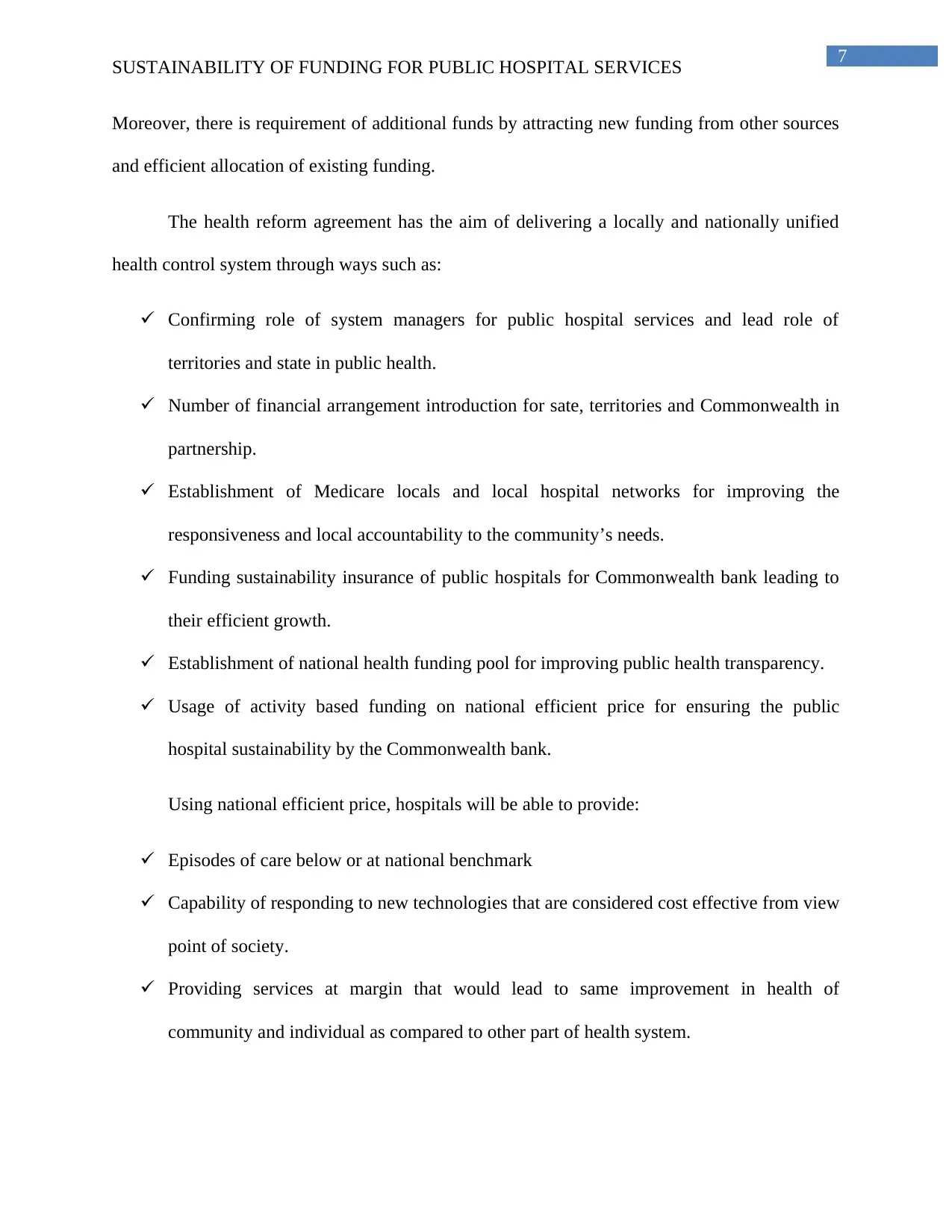
7
SUSTAINABILITY OF FUNDING FOR PUBLIC HOSPITAL SERVICES
Moreover, there is requirement of additional funds by attracting new funding from other sources
and efficient allocation of existing funding.
The health reform agreement has the aim of delivering a locally and nationally unified
health control system through ways such as:
Confirming role of system managers for public hospital services and lead role of
territories and state in public health.
Number of financial arrangement introduction for sate, territories and Commonwealth in
partnership.
Establishment of Medicare locals and local hospital networks for improving the
responsiveness and local accountability to the community’s needs.
Funding sustainability insurance of public hospitals for Commonwealth bank leading to
their efficient growth.
Establishment of national health funding pool for improving public health transparency.
Usage of activity based funding on national efficient price for ensuring the public
hospital sustainability by the Commonwealth bank.
Using national efficient price, hospitals will be able to provide:
Episodes of care below or at national benchmark
Capability of responding to new technologies that are considered cost effective from view
point of society.
Providing services at margin that would lead to same improvement in health of
community and individual as compared to other part of health system.
SUSTAINABILITY OF FUNDING FOR PUBLIC HOSPITAL SERVICES
Moreover, there is requirement of additional funds by attracting new funding from other sources
and efficient allocation of existing funding.
The health reform agreement has the aim of delivering a locally and nationally unified
health control system through ways such as:
Confirming role of system managers for public hospital services and lead role of
territories and state in public health.
Number of financial arrangement introduction for sate, territories and Commonwealth in
partnership.
Establishment of Medicare locals and local hospital networks for improving the
responsiveness and local accountability to the community’s needs.
Funding sustainability insurance of public hospitals for Commonwealth bank leading to
their efficient growth.
Establishment of national health funding pool for improving public health transparency.
Usage of activity based funding on national efficient price for ensuring the public
hospital sustainability by the Commonwealth bank.
Using national efficient price, hospitals will be able to provide:
Episodes of care below or at national benchmark
Capability of responding to new technologies that are considered cost effective from view
point of society.
Providing services at margin that would lead to same improvement in health of
community and individual as compared to other part of health system.
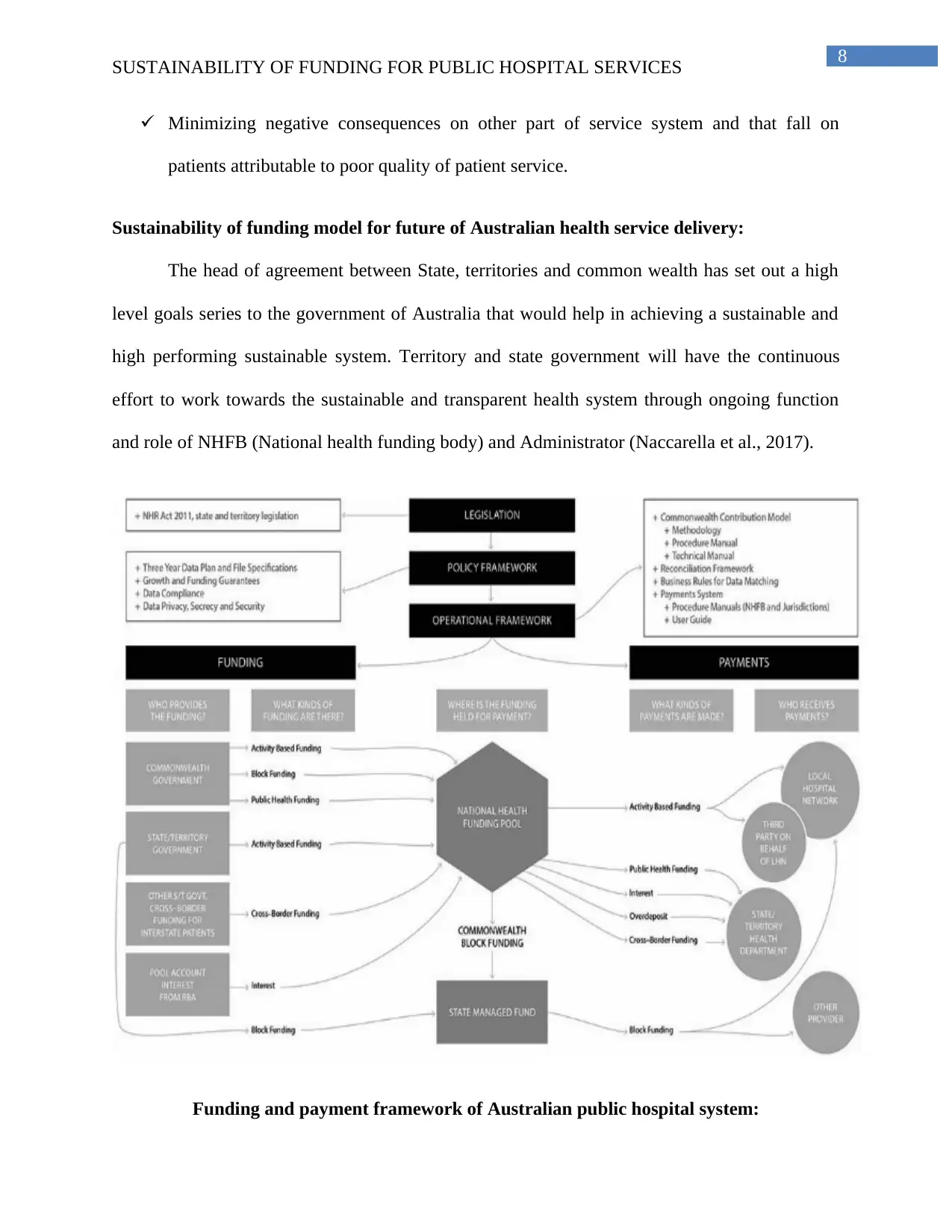
8
SUSTAINABILITY OF FUNDING FOR PUBLIC HOSPITAL SERVICES
Minimizing negative consequences on other part of service system and that fall on
patients attributable to poor quality of patient service.
Sustainability of funding model for future of Australian health service delivery:
The head of agreement between State, territories and common wealth has set out a high
level goals series to the government of Australia that would help in achieving a sustainable and
high performing sustainable system. Territory and state government will have the continuous
effort to work towards the sustainable and transparent health system through ongoing function
and role of NHFB (National health funding body) and Administrator (Naccarella et al., 2017).
Funding and payment framework of Australian public hospital system:
SUSTAINABILITY OF FUNDING FOR PUBLIC HOSPITAL SERVICES
Minimizing negative consequences on other part of service system and that fall on
patients attributable to poor quality of patient service.
Sustainability of funding model for future of Australian health service delivery:
The head of agreement between State, territories and common wealth has set out a high
level goals series to the government of Australia that would help in achieving a sustainable and
high performing sustainable system. Territory and state government will have the continuous
effort to work towards the sustainable and transparent health system through ongoing function
and role of NHFB (National health funding body) and Administrator (Naccarella et al., 2017).
Funding and payment framework of Australian public hospital system:
⊘ This is a preview!⊘
Do you want full access?
Subscribe today to unlock all pages.

Trusted by 1+ million students worldwide
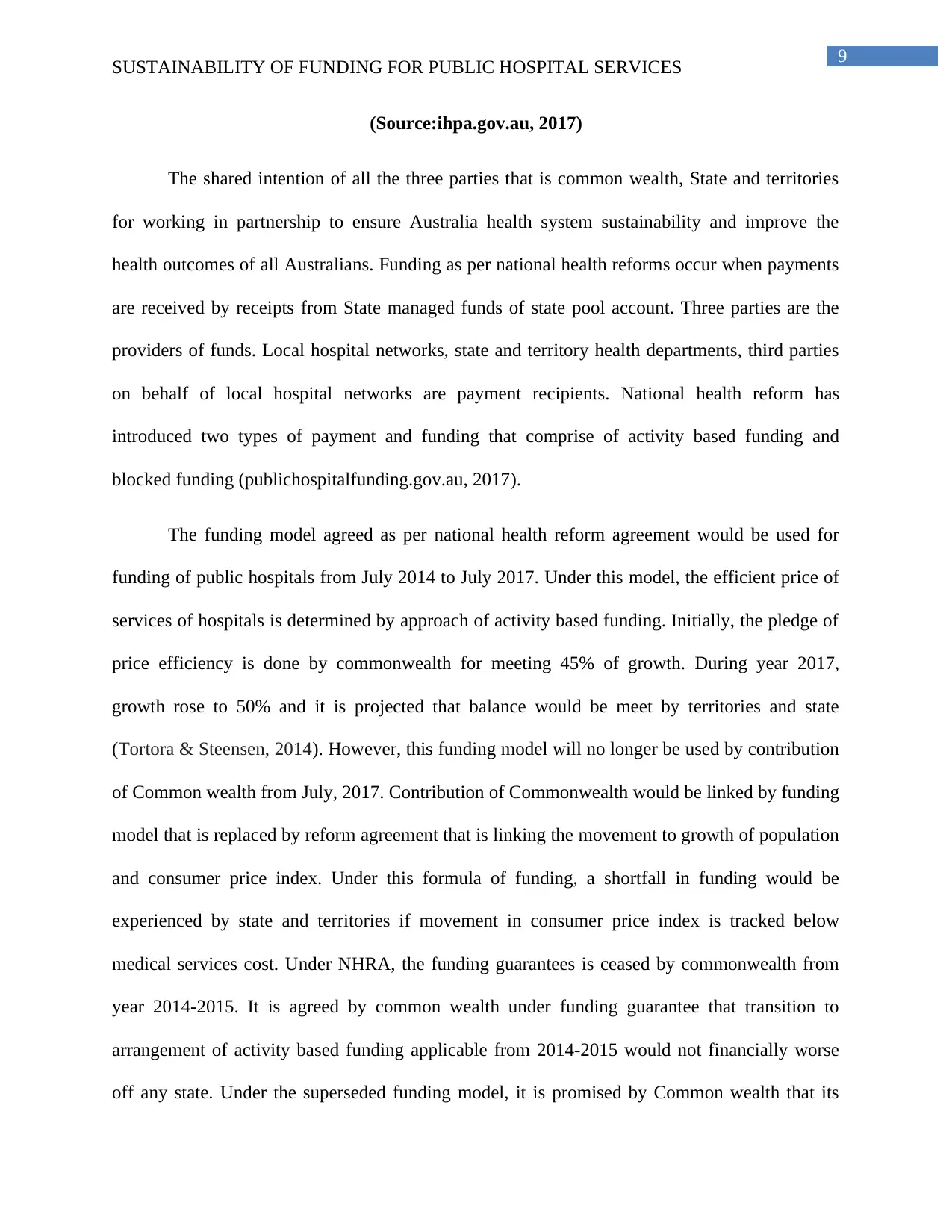
9
SUSTAINABILITY OF FUNDING FOR PUBLIC HOSPITAL SERVICES
(Source:ihpa.gov.au, 2017)
The shared intention of all the three parties that is common wealth, State and territories
for working in partnership to ensure Australia health system sustainability and improve the
health outcomes of all Australians. Funding as per national health reforms occur when payments
are received by receipts from State managed funds of state pool account. Three parties are the
providers of funds. Local hospital networks, state and territory health departments, third parties
on behalf of local hospital networks are payment recipients. National health reform has
introduced two types of payment and funding that comprise of activity based funding and
blocked funding (publichospitalfunding.gov.au, 2017).
The funding model agreed as per national health reform agreement would be used for
funding of public hospitals from July 2014 to July 2017. Under this model, the efficient price of
services of hospitals is determined by approach of activity based funding. Initially, the pledge of
price efficiency is done by commonwealth for meeting 45% of growth. During year 2017,
growth rose to 50% and it is projected that balance would be meet by territories and state
(Tortora & Steensen, 2014). However, this funding model will no longer be used by contribution
of Common wealth from July, 2017. Contribution of Commonwealth would be linked by funding
model that is replaced by reform agreement that is linking the movement to growth of population
and consumer price index. Under this formula of funding, a shortfall in funding would be
experienced by state and territories if movement in consumer price index is tracked below
medical services cost. Under NHRA, the funding guarantees is ceased by commonwealth from
year 2014-2015. It is agreed by common wealth under funding guarantee that transition to
arrangement of activity based funding applicable from 2014-2015 would not financially worse
off any state. Under the superseded funding model, it is promised by Common wealth that its
SUSTAINABILITY OF FUNDING FOR PUBLIC HOSPITAL SERVICES
(Source:ihpa.gov.au, 2017)
The shared intention of all the three parties that is common wealth, State and territories
for working in partnership to ensure Australia health system sustainability and improve the
health outcomes of all Australians. Funding as per national health reforms occur when payments
are received by receipts from State managed funds of state pool account. Three parties are the
providers of funds. Local hospital networks, state and territory health departments, third parties
on behalf of local hospital networks are payment recipients. National health reform has
introduced two types of payment and funding that comprise of activity based funding and
blocked funding (publichospitalfunding.gov.au, 2017).
The funding model agreed as per national health reform agreement would be used for
funding of public hospitals from July 2014 to July 2017. Under this model, the efficient price of
services of hospitals is determined by approach of activity based funding. Initially, the pledge of
price efficiency is done by commonwealth for meeting 45% of growth. During year 2017,
growth rose to 50% and it is projected that balance would be meet by territories and state
(Tortora & Steensen, 2014). However, this funding model will no longer be used by contribution
of Common wealth from July, 2017. Contribution of Commonwealth would be linked by funding
model that is replaced by reform agreement that is linking the movement to growth of population
and consumer price index. Under this formula of funding, a shortfall in funding would be
experienced by state and territories if movement in consumer price index is tracked below
medical services cost. Under NHRA, the funding guarantees is ceased by commonwealth from
year 2014-2015. It is agreed by common wealth under funding guarantee that transition to
arrangement of activity based funding applicable from 2014-2015 would not financially worse
off any state. Under the superseded funding model, it is promised by Common wealth that its
Paraphrase This Document
Need a fresh take? Get an instant paraphrase of this document with our AI Paraphraser
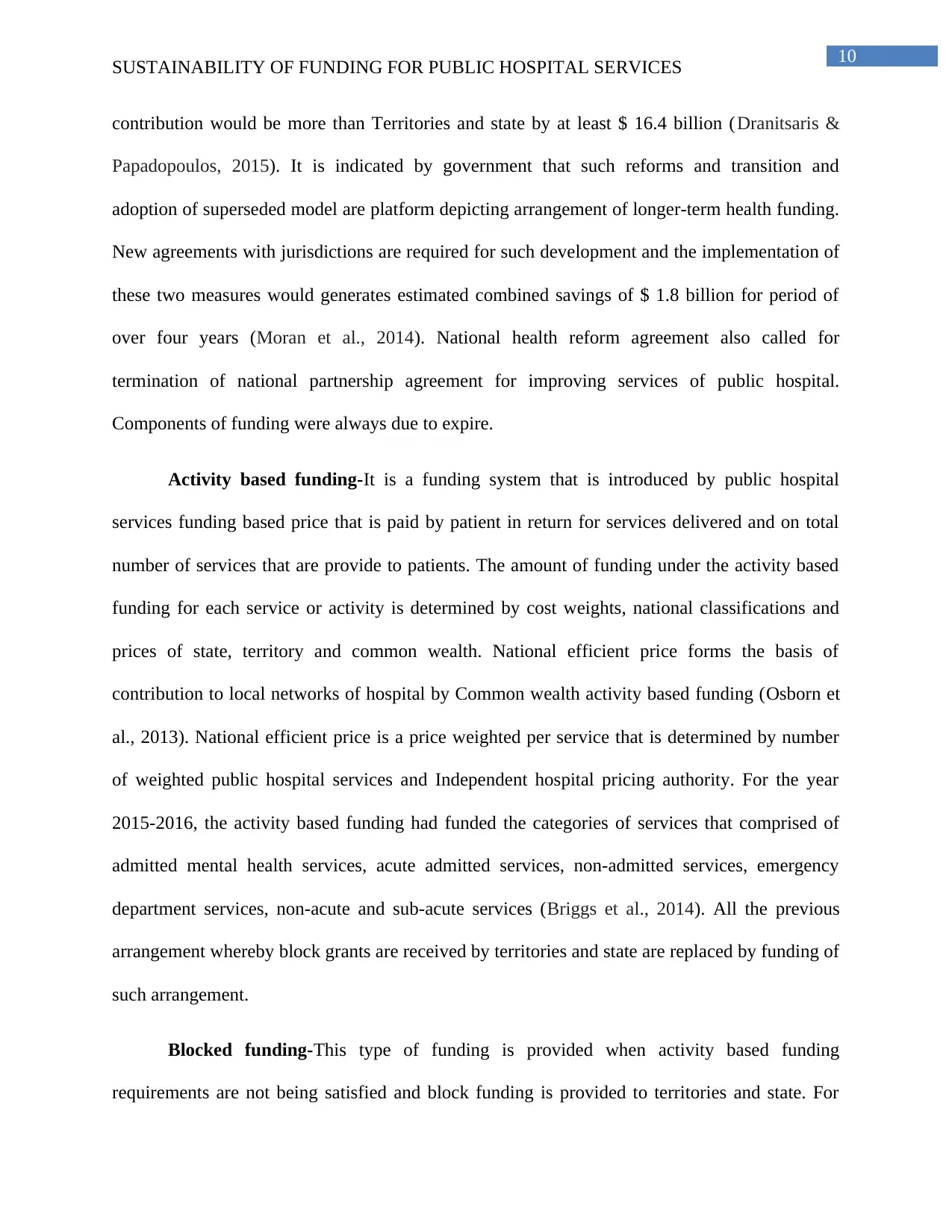
10
SUSTAINABILITY OF FUNDING FOR PUBLIC HOSPITAL SERVICES
contribution would be more than Territories and state by at least $ 16.4 billion (Dranitsaris &
Papadopoulos, 2015). It is indicated by government that such reforms and transition and
adoption of superseded model are platform depicting arrangement of longer-term health funding.
New agreements with jurisdictions are required for such development and the implementation of
these two measures would generates estimated combined savings of $ 1.8 billion for period of
over four years (Moran et al., 2014). National health reform agreement also called for
termination of national partnership agreement for improving services of public hospital.
Components of funding were always due to expire.
Activity based funding-It is a funding system that is introduced by public hospital
services funding based price that is paid by patient in return for services delivered and on total
number of services that are provide to patients. The amount of funding under the activity based
funding for each service or activity is determined by cost weights, national classifications and
prices of state, territory and common wealth. National efficient price forms the basis of
contribution to local networks of hospital by Common wealth activity based funding (Osborn et
al., 2013). National efficient price is a price weighted per service that is determined by number
of weighted public hospital services and Independent hospital pricing authority. For the year
2015-2016, the activity based funding had funded the categories of services that comprised of
admitted mental health services, acute admitted services, non-admitted services, emergency
department services, non-acute and sub-acute services (Briggs et al., 2014). All the previous
arrangement whereby block grants are received by territories and state are replaced by funding of
such arrangement.
Blocked funding-This type of funding is provided when activity based funding
requirements are not being satisfied and block funding is provided to territories and state. For
SUSTAINABILITY OF FUNDING FOR PUBLIC HOSPITAL SERVICES
contribution would be more than Territories and state by at least $ 16.4 billion (Dranitsaris &
Papadopoulos, 2015). It is indicated by government that such reforms and transition and
adoption of superseded model are platform depicting arrangement of longer-term health funding.
New agreements with jurisdictions are required for such development and the implementation of
these two measures would generates estimated combined savings of $ 1.8 billion for period of
over four years (Moran et al., 2014). National health reform agreement also called for
termination of national partnership agreement for improving services of public hospital.
Components of funding were always due to expire.
Activity based funding-It is a funding system that is introduced by public hospital
services funding based price that is paid by patient in return for services delivered and on total
number of services that are provide to patients. The amount of funding under the activity based
funding for each service or activity is determined by cost weights, national classifications and
prices of state, territory and common wealth. National efficient price forms the basis of
contribution to local networks of hospital by Common wealth activity based funding (Osborn et
al., 2013). National efficient price is a price weighted per service that is determined by number
of weighted public hospital services and Independent hospital pricing authority. For the year
2015-2016, the activity based funding had funded the categories of services that comprised of
admitted mental health services, acute admitted services, non-admitted services, emergency
department services, non-acute and sub-acute services (Briggs et al., 2014). All the previous
arrangement whereby block grants are received by territories and state are replaced by funding of
such arrangement.
Blocked funding-This type of funding is provided when activity based funding
requirements are not being satisfied and block funding is provided to territories and state. For
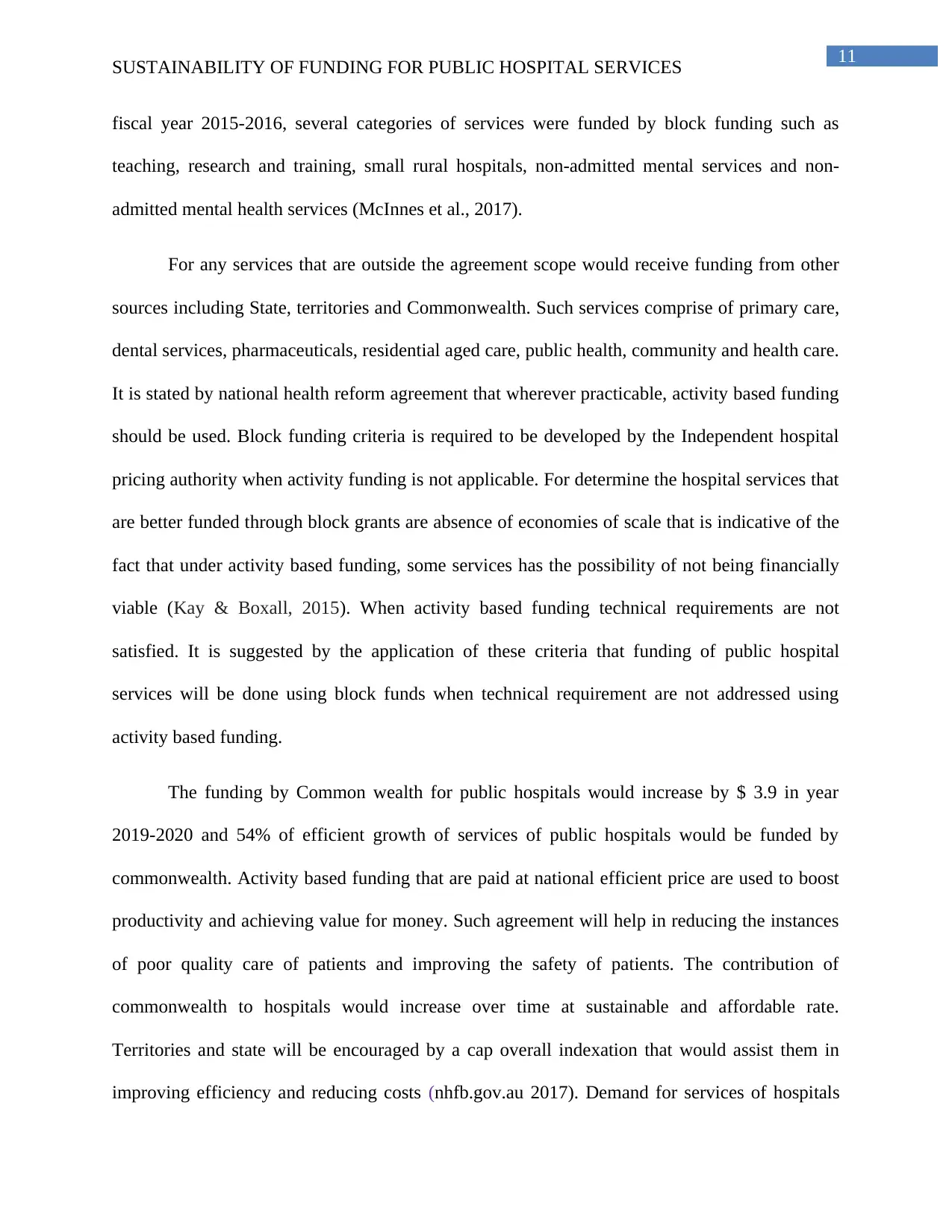
11
SUSTAINABILITY OF FUNDING FOR PUBLIC HOSPITAL SERVICES
fiscal year 2015-2016, several categories of services were funded by block funding such as
teaching, research and training, small rural hospitals, non-admitted mental services and non-
admitted mental health services (McInnes et al., 2017).
For any services that are outside the agreement scope would receive funding from other
sources including State, territories and Commonwealth. Such services comprise of primary care,
dental services, pharmaceuticals, residential aged care, public health, community and health care.
It is stated by national health reform agreement that wherever practicable, activity based funding
should be used. Block funding criteria is required to be developed by the Independent hospital
pricing authority when activity funding is not applicable. For determine the hospital services that
are better funded through block grants are absence of economies of scale that is indicative of the
fact that under activity based funding, some services has the possibility of not being financially
viable (Kay & Boxall, 2015). When activity based funding technical requirements are not
satisfied. It is suggested by the application of these criteria that funding of public hospital
services will be done using block funds when technical requirement are not addressed using
activity based funding.
The funding by Common wealth for public hospitals would increase by $ 3.9 in year
2019-2020 and 54% of efficient growth of services of public hospitals would be funded by
commonwealth. Activity based funding that are paid at national efficient price are used to boost
productivity and achieving value for money. Such agreement will help in reducing the instances
of poor quality care of patients and improving the safety of patients. The contribution of
commonwealth to hospitals would increase over time at sustainable and affordable rate.
Territories and state will be encouraged by a cap overall indexation that would assist them in
improving efficiency and reducing costs (nhfb.gov.au 2017). Demand for services of hospitals
SUSTAINABILITY OF FUNDING FOR PUBLIC HOSPITAL SERVICES
fiscal year 2015-2016, several categories of services were funded by block funding such as
teaching, research and training, small rural hospitals, non-admitted mental services and non-
admitted mental health services (McInnes et al., 2017).
For any services that are outside the agreement scope would receive funding from other
sources including State, territories and Commonwealth. Such services comprise of primary care,
dental services, pharmaceuticals, residential aged care, public health, community and health care.
It is stated by national health reform agreement that wherever practicable, activity based funding
should be used. Block funding criteria is required to be developed by the Independent hospital
pricing authority when activity funding is not applicable. For determine the hospital services that
are better funded through block grants are absence of economies of scale that is indicative of the
fact that under activity based funding, some services has the possibility of not being financially
viable (Kay & Boxall, 2015). When activity based funding technical requirements are not
satisfied. It is suggested by the application of these criteria that funding of public hospital
services will be done using block funds when technical requirement are not addressed using
activity based funding.
The funding by Common wealth for public hospitals would increase by $ 3.9 in year
2019-2020 and 54% of efficient growth of services of public hospitals would be funded by
commonwealth. Activity based funding that are paid at national efficient price are used to boost
productivity and achieving value for money. Such agreement will help in reducing the instances
of poor quality care of patients and improving the safety of patients. The contribution of
commonwealth to hospitals would increase over time at sustainable and affordable rate.
Territories and state will be encouraged by a cap overall indexation that would assist them in
improving efficiency and reducing costs (nhfb.gov.au 2017). Demand for services of hospitals
⊘ This is a preview!⊘
Do you want full access?
Subscribe today to unlock all pages.

Trusted by 1+ million students worldwide
1 out of 19
Related Documents
Your All-in-One AI-Powered Toolkit for Academic Success.
+13062052269
info@desklib.com
Available 24*7 on WhatsApp / Email
![[object Object]](/_next/static/media/star-bottom.7253800d.svg)
Unlock your academic potential
Copyright © 2020–2025 A2Z Services. All Rights Reserved. Developed and managed by ZUCOL.




